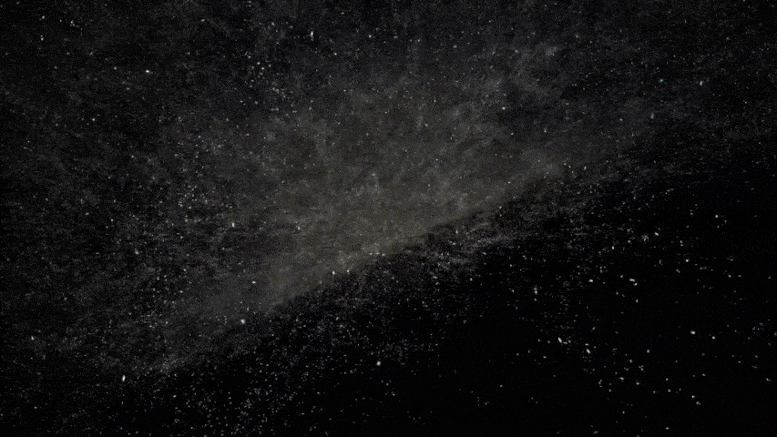
An international consortium of scientists has analyzed, as part of a vast program of cosmological studies, several million galaxies and quasars, returning to a more continuous history of the Universe and offering a better understanding of the mechanisms of its expansion. The last 6-year survey called eBOSS was initiated and led in part by EPFL astrophysicist Jean-Paul Kneib.
It is the largest 3D map of the Universe produced to date. It is the fruit of a twenty-year collaboration of several hundred scientists from around thirty different institutions around the world, all united in the “Sloan Digital Sky Survey” (SDSS), with data collected from an optical telescope dedicated to the project located in New Mexico, in the United States.
Launched today in the form of more than twenty scientific publications, this latest mapping of the night sky is an unprecedented and ambitious astronomical survey from 2014 to 2020. As a result of analysis of several million galaxies and quasars, this latest survey is based on existing data as early as 1998 to fill certain gaps in cosmological history and improve our understanding of the mechanisms underlying the expansion of the Universe.
EPFL (Ecole polytechnique fédérale de Lausanne) participates directly in this important project. This latest SDSS cosmological study, called “The Extended Baryon Oscillation Spectroscopic Study” (eBOSS), includes more than 100 astrophysicists, several of whom are EPFL researchers. Jean-Paul Kneib, who heads the EPFL Astrophysics Laboratory (LASTRO), started the eBOSS survey and was its principal investigator (PI) for several years.
“In 2012, I launched the eBOSS project with the idea of producing the most complete 3D map of the Universe throughout the life of the Universe, implementing for the first time celestial objects that indicate the distribution of matter in the distant Universe, the galaxies that actively form stars and quasars, “reports Jean-Paul Kneib.” It is a great pleasure to see the completion of this work today. “

Jean-Paul Kneib. Credit: EPFL
Thanks to the extensive theoretical models that describe the Universe after the big BangAs well as observing cosmic microwave background radiation (CMBR), the infant universe is relatively well known. Scientists have also explored its history of expansion in the last few billion years from distance measurements of Supernovas and galaxy maps, including those from earlier phases of the SDSS. “We know the ancient history of the universe and its recent history of expansion quite well, but there is a problematic gap in the middle of 11 billion years,” says cosmologist Kyle Dawson of the University of Utah, who leads the team announcing the today’s results. “Thanks to five years of continuous observations, we have worked to fill that gap, and we are using that information to provide some of the most important advances in cosmology in the past decade.”
“Taken together, detailed analyzes of the eBOSS map and previous SDSS experiments, we have now provided the most accurate expansion history measurements in the widest range of cosmic time,” says Will Percival of the University of Waterloo, EBOSS Survey Scientist. “These studies allow us to connect all of these measurements into a complete history of the expansion of the Universe.”

The SDSS map is shown as a rainbow of colors, located within the observable Universe (the outer sphere, which shows fluctuations in the Cosmic Microwave Background).
We are located in the center of this map. The box for each color-coded section of the map includes an image of a typical galaxy or quasar from that section, and also the pattern signal that the eBOSS team measures there. As we look into the distance, we look back in time. So the location of these signals reveals the rate of expansion of the Universe at different times in cosmic history.
Credit: Anand Raichoor (EPFL), Ashley Ross (Ohio State University) and the SDSS Collaboration
The final map shows strands of matter and voids that more precisely define the structure of the Universe from its beginnings, when it was only 380,000 years old. From there, the researchers measured recurring patterns in the distribution of galaxies, thus identifying several key cosmological parameters, including hypothetical dark matter density and energy in the Universe, with a high degree of precision.
To carry out this survey, the teams involved in the eBOSS project observed different galactic tracers that reveal the massive distribution in the Universe. For the part of the map related to the Universe six billion years ago, researchers looked at the oldest and reddest galaxies. For more distant times, they concentrated on the youngest galaxies, the blue ones. To go further, that is, up to eleven billion years, they used quasars, galaxies whose supermassions dungeon It is extremely bright.
Slower expansion?
This map reveals the history of the Universe, and in particular, that the expansion of the Universe began to accelerate at some point and has continued to do so ever since. This appears to be due to the presence of dark energy, an invisible element that naturally fits into Einstein’s general theory of relativity but whose origin is not yet understood.
When eBOSS observations are compared with studies of the early days of the Universe, discrepancies appear in the estimates of the rate of expansion of the Universe. The currently accepted expansion rate, called the “Hubble constant”, is 10% slower than the value calculated from the distances between the galaxies closest to us. This 10% difference is unlikely to be random due to the high precision and wide variety of data in the eBOSS database.
To date, there is no commonly accepted explanation for these disagreements between different estimates of the rate of expansion, but the fact that a still unknown form of matter or energy from the early Universe may have left its mark on our history is an interesting possibility. .
For more information on this research, including more videos and images, see the largest 3D map of the universe ever created.